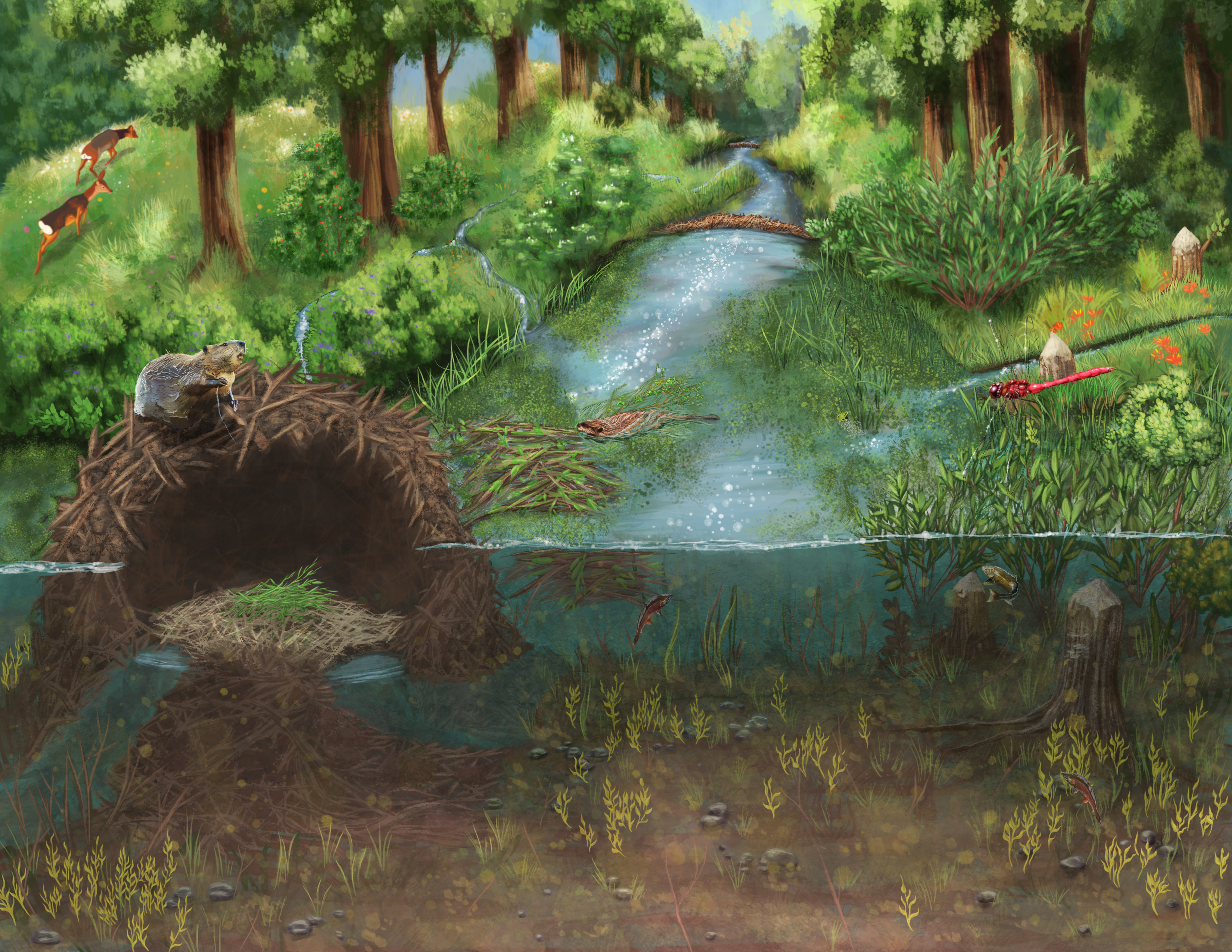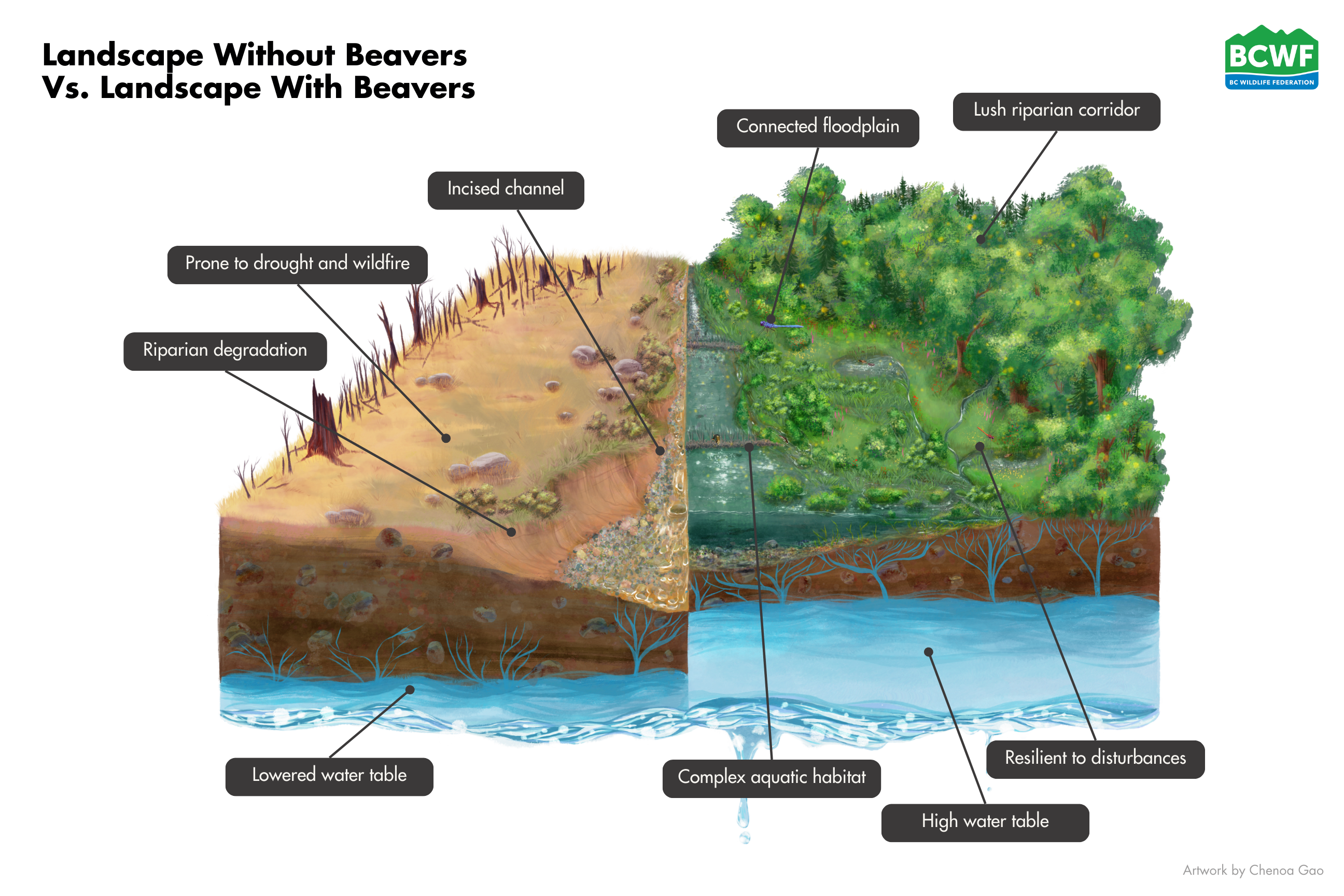In early 2023, the B.C. Wildlife Federation launched 10,000 Wetlands, an ambitious project focused on beaver-based restoration. The 10,000 Wetlands project is designed to confront environmental challenges through installing 100 Beaver Dam Analogues (BDAs) across the province. By partnering with First Nations, Indigenous groups, and environmental NGOs, our overall aim is to kickstart the creation and restoration of over 10,000 wetlands province-wide. The BCWF’s 10,000 Wetlands project is a significant step forward in the Federation’s overall efforts to restore and enhance wetland ecosystems, promote biodiversity, and improve watershed resilience through nature-based solutions.
Beaver-Based Restoration in British Columbia
Given the widespread degradation across our watersheds and the low-cost, high-impact outcomes, there is significant interest in beaver-based restoration throughout the province. A few groups have already constructed BDAs in BC; however, restoration techniques involving beavers remain a relatively new approach.
For this reason, the BCWF aims to connect practitioners interested in or actively pursuing beaver-based restoration to share resources and advice, celebrate successes, and learn from setbacks. This collective effort is crucial for advancing the practice of beaver-based restoration in BC.
The approach is supported by four main pillars:
- Policy: Navigating the regulatory regime through which this new restoration approach will be implemented.
- Science: Ensuring data is collected to effectively monitor project sites and inform adaptive management strategies to promote project success.
- Collaboration: Creating and connecting a network of practitioners to learn from and collaborate with each other.
- Implementation: Providing support, both in-kind and financial, to practitioners through the various stages of assessment, design, construction, and monitoring of projects.

A Brief History of the Beaver
Before European colonization, beavers occupied most rivers in North America. Early colonial settlers wrote tales detailing their difficulties travelling through the dam-laden river systems. The fur trade in the 18th and 19th century prompted the persecution of beavers and led to drastic population declines.
By the 20th century beavers were extirpated in many areas of their native range. This rapid loss of beavers from valley-bottoms was coupled with the expansion and development of human settlements within highly productive floodplain areas.
Human-made dams and berms were constructed to control water courses. However, this human manipulation of river systems, combined with the absence of beaver influence, disrupted the natural ecosystem equilibrium. This led to more degraded habitats that were less resilient to disturbances. Streams became disconnected from their floodplains, and landscapes were not able to retain as much water which led to heightened flood, drought, and erosion events.
Laying the Groundwork for Beaver-based Restoration
Under the leadership of the BCWF’s Beaver Restoration Assessment Lead, Jennifer Rogers, extensive site assessments were conducted throughout 2023 with key focus areas in the Thompson-Okanagan, Kootenay, and Cariboo regions. The purpose of these site assessments was to identify potential sites where BDAs could be built to mimic the ecological functions of natural beaver dams. In total, 61 potential sites were evaluated for BDA implementation. This work was done in collaboration with 11 First Nations communities and 9 other organizations, including nonprofits, academic institutions, and government entities. Upon evaluation, 8 sites have been selected as priorities for our 10,000 Wetlands project. With planning underway, we aim to maintain this momentum into 2024 by constructing up to 77 BDAs at priority sites and conducting field assessments to identify opportunities for 2025.
In addition to conducting site assessments, the BCWF also spent much of 2023 engaging in dialogues with provincial regulators to navigate the complexities of permitting for this innovative restoration technique. In collaboration with experts, the BCWF developed monitoring protocols to assess the effectiveness of BDAs, aiming to refine the science and understanding of beaver-based restoration under various environmental conditions. This collaborative effort seeks to enhance future projects and expand the applicability of BDAs across British Columbia.
Economic and Environmental Benefits
Harnessing the natural water-retention capabilities of beaver dams offers an economical approach to wetland restoration and watershed resilience. By encouraging beavers to take over and improve upon BDAs, their expertise in dam building is utilized to enhance water retention.
Beaver dam-building enhances water retention, boosts summer stream flows, and bolsters resilience to drought, flood, and fire. Their contribution to watershed management provides a more efficient, cost-effective, and sustainable solution than traditional infrastructure, decreasing dependency on costly human-managed services.
Furthermore, Beavers have been shaping our riverscapes for over one million years. They are often referred to as “ecosystem engineers” for their ability to create and expand habitats with the construction of dams. So many species rely on habitats created by beavers that they are considered a “keystone species,” integral to the healthy functioning of ecosystems in which they are native to. This includes almost all of Canada and the U.S. Beaver dams impound water, which activates floodplains and helps recharge groundwater stores.
Dams promote a diverse range of flow conditions and water depths. This variety of habitat allows many species to flourish, as there are areas to rest, forage, and reproduce. Beavers are becoming increasingly known as climate heroes for their ability to mitigate the severity of climate-driven events such as floods, droughts, and fires. Beavers help mitigate flooding by storing water in the landscape, which enables excess water to spill onto the floodplain rather than eroding the streambed. In terms of fire mitigation, beavers contribute by storing more surface and groundwater on the landscape, which keeps vegetation greener and less prone to fire. Regarding drought mitigation, beaver dams gradually release stored water throughout the seasons, thereby augmenting summer low flows that would otherwise lead to droughts.
 Thank you to the Government of Canada, Habitat Conservation Trust Foundation, and Province of BC for funding this work.
Thank you to the Government of Canada, Habitat Conservation Trust Foundation, and Province of BC for funding this work.
This article was written by:
Jamie Long, Conservation Stewardship Communications Coordinator, B.C. Wildlife Federation
For more information on the BCWF’s 10,000 Wetlands project, please contact Jennifer Rogers; Beaver Restoration Assessment Lead, B.C. Wildlife Federation
